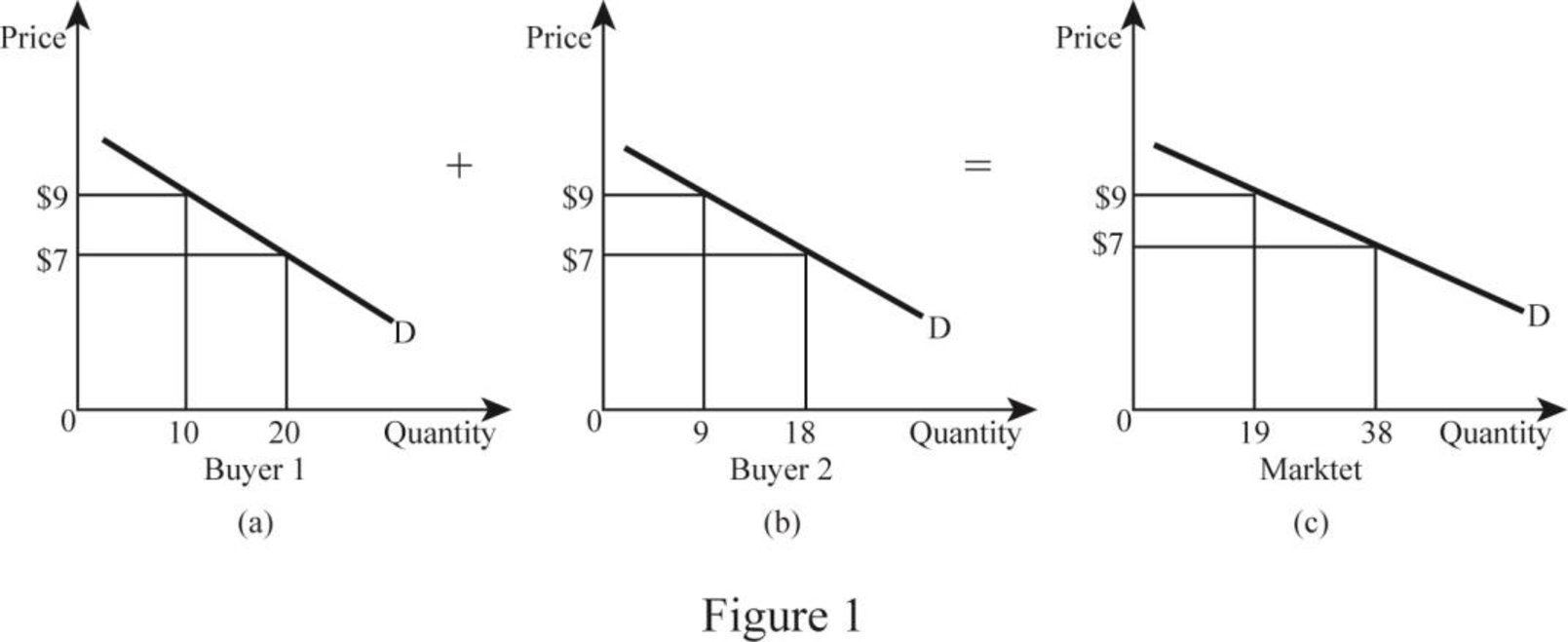
Derivation of the market
Explanation of Solution
The market demand curve can be derived by adding each individual’s quantity demand at a different

In Figure 1, both panels (a) and (b) indicate the individual demand curve of Buyer 1 and Buyer 2, respectively, where the horizontal axis represents quantity demanded and the vertical axis represents the price of the good. In the figure, Buyer 1 demanded 10 units and Buyer 2 demanded 9 units at $9. Therefore, the total quantity demanded at $9 is 19 units. Similarly, Buyer 1 demanded 20 units and Buyer 2 demanded 18 units at $7. Hence, the total quantity demanded at $7 is 38 units. In Panel (c), the vertical axis represents the total quantity demanded in the market and the vertical axis represents price. By plotting each individual’s quantity demand at different prices creates a market demand curve.
Demand curve: A demand curve shows the level of quantity demanded at different price levels. Since there is a negative relationship between the price and the quantity, the demand curve slopes downward.
Want to see more full solutions like this?
Chapter 3 Solutions
Macroeconomics (Book Only)
- Answerarrow_forwardM” method Given the following model, solve by the method of “M”. (see image)arrow_forwardAs indicated in the attached image, U.S. earnings for high- and low-skill workers as measured by educational attainment began diverging in the 1980s. The remaining questions in this problem set use the model for the labor market developed in class to walk through potential explanations for this trend. 1. Assume that there are just two types of workers, low- and high-skill. As a result, there are two labor markets: supply and demand for low-skill workers and supply and demand for high-skill workers. Using two carefully drawn labor-market figures, show that an increase in the demand for high skill workers can explain an increase in the relative wage of high-skill workers. 2. Using the same assumptions as in the previous question, use two carefully drawn labor-market figures to show that an increase in the supply of low-skill workers can explain an increase in the relative wage of high-skill workers.arrow_forward
- Published in 1980, the book Free to Choose discusses how economists Milton Friedman and Rose Friedman proposed a one-sided view of the benefits of a voucher system. However, there are other economists who disagree about the potential effects of a voucher system.arrow_forwardThe following diagram illustrates the demand and marginal revenue curves facing a monopoly in an industry with no economies or diseconomies of scale. In the short and long run, MC = ATC. a. Calculate the values of profit, consumer surplus, and deadweight loss, and illustrate these on the graph. b. Repeat the calculations in part a, but now assume the monopoly is able to practice perfect price discrimination.arrow_forwardThe projects under the 'Build, Build, Build' program: how these projects improve connectivity and ease of doing business in the Philippines?arrow_forward
 Economics Today and Tomorrow, Student EditionEconomicsISBN:9780078747663Author:McGraw-HillPublisher:Glencoe/McGraw-Hill School Pub Co
Economics Today and Tomorrow, Student EditionEconomicsISBN:9780078747663Author:McGraw-HillPublisher:Glencoe/McGraw-Hill School Pub Co Economics (MindTap Course List)EconomicsISBN:9781337617383Author:Roger A. ArnoldPublisher:Cengage Learning
Economics (MindTap Course List)EconomicsISBN:9781337617383Author:Roger A. ArnoldPublisher:Cengage Learning

 Exploring EconomicsEconomicsISBN:9781544336329Author:Robert L. SextonPublisher:SAGE Publications, Inc
Exploring EconomicsEconomicsISBN:9781544336329Author:Robert L. SextonPublisher:SAGE Publications, Inc





